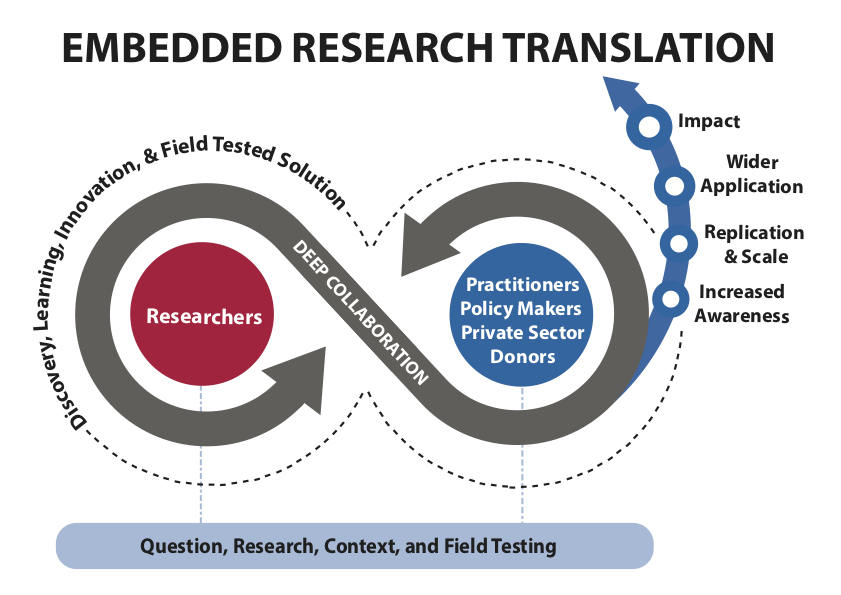Embedded Research Translation
Embedded Research Translation
Increasingly, researchers, practitioners, policy makers and donors are interested in research that generates on-the-ground solutions to development challenges. A common approach to this form of knowledge transfer is a two-phase process in which research findings are translated into practical applications after the research has concluded. LASER PULSE, however, approaches research translation as an integrated component of the entire research cycle, built in from the very beginning of the project instead of as a final phase in the research process. LASER PULSE affirms that research translation is most effective if it is embedded across all phases of the research project from identifying the research topic to disseminating the findings for broader impact and scale.
Central to LASER PULSE’s approach to research translation is its ability to bridge researchers, thought leaders, innovators, and scientists with practitioners on the ground doing the work – including NGO, civil society, private sector and government actors – around the same development targets. Recognizing that research translation is an iterative, collaborative process, LASER PULSE promotes a model in which development solutions are derived through a co-development process between practitioners and researchers. Once these key actors are connected, Embedded Research Translation serves as the means for collaborating on research solutions for development.
THE LASER PULSE MODEL
LASER PULSE defines Embedded Research Translation as an iterative co-design process among academics, practitioners, and other stakeholders in which research is intentionally applied to a development challenge. Core to this approach are four pillars- partnership, process, product, and dissemination (Figure 1 - below).
 Partnership: By integrating translation partners early and throughout the research collaboration, the model ensures that the research solution is custom generated for the development challenge and the outcomes are more readily adapted and applied by practitioners.
Partnership: By integrating translation partners early and throughout the research collaboration, the model ensures that the research solution is custom generated for the development challenge and the outcomes are more readily adapted and applied by practitioners.
Process: Through establishing a collaborative partnership process, the researcher and practitioner team ensure they have a solid foundation to work together effectively on development research.
Product: The model emphasizes that while innovative and evidence-based research is important, it ultimately needs to result in a co-designed translation product that informs policy and/or practice. Translation products should lead to changes or recommendations in legal, funding, accountability, feasibility, or implementation mechanisms.
Dissemination: LASER PULSE seeks not just to increase research capacity, output and translation, but also research dissemination and use. Including a dissemination plan enables wider application and scale-up beyond the initial translation partnership and toward a larger uptake of relevant findings in the field or region.
EMBEDDED RESEARCH TRANSLATION IN PRACTICE
LASER PULSE believes innovation and discovery can occur in research laboratories, in the field, as well as through the learning process throughout the implementation and scaling phases. Pathways to innovative, field-tested solutions are reinforced through deep collaboration with the stakeholders closest to the development challenge, and more specifically practitioners working to solve it (Figure 2 - below).
 LASER PULSE strengthens the capacity of practitioners to navigate the world of research and for researchers to become more deeply aware and integrated into the programming and policy spheres of development.
LASER PULSE strengthens the capacity of practitioners to navigate the world of research and for researchers to become more deeply aware and integrated into the programming and policy spheres of development.
LASER PULSE integrates embedded research translation across all its activities to ensure research is translated into policy and practice for development impact by:
- facilitating connection between researchers and practitioners stakeholders (public, private, non-profit) via the LASER PULSE network;
- ensuring that Research for Development (R4D) conferences and virtual workshops are engaging and accessible to both researchers and practitioners;
- supporting the deep collaboration between researchers and practitioners through the RFA sub-granting process;
- working with researchers to ensure that research results are adapted into formats that practitioners can easily understand and use; and,
- supporting the dissemination of translated research products to encourage scale and wider application.
MEASUREMENT OF EMBEDDED RESEARCH TRANSLATION
As LASER PULSE sees the trajectory of translation as a cyclical process from discovery to field tested solution to wider application to impact, it is difficult to determine one finite point when translation is complete. As research translation progresses along its trajectory (Figure 2), it is possible to measure success by examining the outcomes of the research itself, the outputs of the translated products and their dissemination, the outcomes of their use, and then finally, the impact of that wider application. While a full evaluation of research translation impact is beyond LASER PULSE’s sphere of operation, the project works to support researcher and practitioner stakeholders to understand the goals of translation and strategies to support its successful implementation.
ADDITIONAL RESOURCES
LASER PULSE is committed to delivering practical, research-driven solutions to global development challenges through building the capacity of researchers and practitioners to collaborate more effectively. Additional resources and opportunities for engagement around Embedded Research Translation include:
- Network - connect and engage with researchers and practitioners around the world
- Introduction to Research Translation Online Course - free introductory course on Embedded Research Translation
- Support Materials and Additional Online Modules on Research Translation - Digital tools, templates, and trainings to support key components of research translation planning and implementation for projects
- External Resources on Research Translation - curated library of resources and publications on research translation
- Practitioner-Researcher Toolkit (coming in 2021) - tools, templates, and guides to improve collaboration between researchers and practitioners
